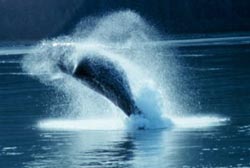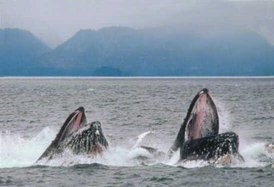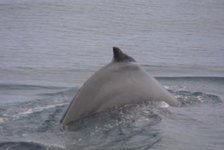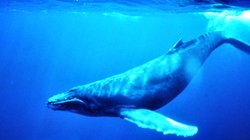Humpback Whale
|
|
| Humpback Whale Conservation status: Vulnerable | ||||||||||||||||||
|---|---|---|---|---|---|---|---|---|---|---|---|---|---|---|---|---|---|---|
 | ||||||||||||||||||
| Scientific classification | ||||||||||||||||||
| ||||||||||||||||||
| Binomial name | ||||||||||||||||||
| Megaptera novaeangliae (Borowski, 1781) | ||||||||||||||||||
 Humpback Whale range |
The Humpback Whale (Megaptera novaeangliae) is a mammal which belongs to the baleen whale suborder. It is a large whale: an adult usually ranges between 12–16 m long and weighs approximately 36 tonnes. It is well known for its breaching (leaping out of the water), its unusually long front fins, and its complex whale song. The Humpback Whale lives in oceans and seas around the world, and is regularly sought out by whale-watchers.
| Contents |
Physical description
Humpback Whales can easily be identified by their stocky bodies with obvious humps and black upper parts. The head and lower jaw are covered with knobs called tubercles, which are actually hair follicles and are characteristic of the species. The tail flukes, which are lifted high in the dive sequence, have wavy rear edges.
The long (up to a third of body length) black and white tail fin and pectoral fins have unique patterns, which enable individual whales to be recognised, in a similar way to the bill markings on Bewick's Swans. Several hypotheses have been suggested to explain the evolution of the Humpback's pectoral fins, proportionally the longest fins of any cetacean. The two most enduring hypotheses are that the higher maneuverability afforded by long fins is a significant evolutionary advantage, or that the increased surface is useful for temperature control when migrating between warm and cold climates.
Humpbacks have 270 to 400 darkly-coloured baleen plates on each side of the mouth. Ventral grooves run from the lower jaw to the umbilicus about halfway along the bottom of the whale. These grooves are less numerous (usually 16–20 in number) and consequently more prominent than in other rorquals. The stubby dorsal fin is visible soon after the blow when the whale surfaces, but has disappeared by the time the flukes emerge. It has a distinctive 3 m bushy blow.
Humpbackwhale00.jpg
The calf is about 4–4.5 metres long when born and weighs approximately 700 kg. Calves are nursed by their mothers for their first six months, then are sustained through a mixture of nursing and independent feeding for a further six months. Calves leave their mothers at the start of their second year, when they are typically 9 metres long. Both sexes reach sexual maturity at the age of five. Full adult size is achieved a little later. Grown size is commonly 15–16 metres in males, 16–17 metres in females, and a weight of 40,000 kg; the largest ever recorded specimen was 19 metres long and had pectoral fins measuring six metres each.
Females have a lobe about six inches in diameter in their genital region that is not present in males. This allows males and females to be distinguished if the underside of the whale can be seen, even though the male's penis almost always remains unseen in the genital slit. Females typically breed every two or three years. The gestation period is eleven months, yet some individuals can breed in two consecutive years.
Humpback Whales can live for 40–50 years.
Social structure and courtship
The Humpback social structure is loose-knit. Usually, individuals live alone or in transient small groups that come together and break up over the course of a few hours. Groups may stay together a little longer in summer in order to forage and feed co-operatively. More long-term relationships between pairs and small groups, lasting months or even years, have been observed, but are rare. The range of the Humpback overlaps considerably with many other whale and dolphin species — but whilst it may be seen in the vicinity of other species (for instance, the Minke Whale), it rarely interacts socially with them.
Courtship rituals take place during the winter months. Competition for a mate is usually fierce. Groups of males of two to twenty in number typically gather around a single female and exhibit a variety of behaviours in order to establish dominance. The displays last several hours and the group size may ebb and flow in number as unsuccessful males retreat and others arrive to try their luck. Techniques used include breaching, spy-hopping, lob-tailing, tail-slapping, flipper-slapping, charging and parrying (see the whale behaviour article for a detailed description of these techniques). The whale song, discussed below, is assumed to have an important role in mate selection; however, scientists remain unsure whether the song is used between males in order to establish identity and dominance, between a male and a female as a mating call, or a mixture of the two. All these vocal and physical techniques have also been observed when there are no potential mates nearby and so are probably important as a more general communication tool.
Feeding
The species feeds only in summer and lives off fat reserves during winter. It is an energetic feeder, taking krill and small schooling fish, such as herring, capelin and sand lance. It will hunt fish by direct attack or by stunning them by hitting the water with its flippers or flukes.
Its most inventive feeding technique is called bubble net fishing. A group of whales swim rapidly in wide circles around and under a school of fish, blowing air through their blowholes. The bubbles form a visual barrier that serves to confine the school within an ever tighter area. The whales then suddenly swim upwards and through the bubble net, mouths agape, swallowing thousands of fish in one gulp. This technique can involve a ring of bubbles up to 30 metres in diameter and the cooperation of a dozen animals at once. It is perhaps the most spectacular act of cooperation among marine mammals.
Humpback Whales are preyed upon by orcas. The result of these attacks is generally nothing more serious than some scarring of the skin. However, it is likely that young calves are sometimes killed.
Whale song
- Main article: whale song
Alongside its aerial acrobatics, the Humpback Whale is well-known for its long and complex "song". The whale repeats patterns of low notes that vary in amplitude and frequency in consistent patterns over a period of hours or even days. The songs only occur during the mating season, so it is supposed that the song is used for courting. Also interesting is the fact that a whale's unique song slowly evolves over a period of years —never returning to the same sequence of notes even after decades.
Population and distribution
The Humpback Whale is found in all the major oceans, in a wide band running from about 60° S to 65° N latitude. It is a migratory species, spending its summers in cooler, high-latitude waters while mating and calving in tropical and sub-tropical waters. Annual migrations of up to 25,000 km (16,000 miles) are typical, making it one of the most well-travelled of any mammalian species. An exception to this rule is a population in the Arabian Sea, which remains in these tropical waters year-round. The species is not found in the eastern Mediterranean, the Baltic Sea or the Arctic Ocean.
The Humpback Whale appears to be recovering much more strongly from the effects of whaling than the other large whales. The population has grown from a low point of 20,000 at the 1966 moratorium to about 35,000 today. By contrast, the blue whale population has remained static at 3,000 over the same period of time. There are estimated to be 11,600 Humpbacks in the North Atlantic, 7,000 in the North Pacific and at least 17,000 in the Southern Hemisphere.
Taxonomy and evolution
The Humpback is the sole member of the genus Megaptera, and is usually classified in its own subfamily Megapterinae within the family Balaenoptiidae, which contains eight other baleen whales. The literal translation of the binomial name is "the New England big-wing", which reflects the large flippers and the location of the first described specimen.
More recent molecular studies indicate that the first filter-feeding whales, of which the Humpbacks are a descendant, arose in the late Eocene period 35–36 million years ago, and that species evolution then slowed for a long time before radiating again in the middle of the Miocene period, 12–15 million years ago. It is not known whether the Humpback species itself arose at this time.
However, the molecular evidence does indicate that the fin and blue whale's lineages separated more than 5 million years ago, and that these species split after the Humpback did. Thus, these molecular studies date the Humpback Whale species as between 5 and 12 million years old. Like other cetacean species, though, the Humpback fossil record becomes very patchy at times greater than 2.5 million years ago, and it is not currently possible to narrow this age range further.
- Further reading: The Emergence of Whales: Evolutionary patterns in the Origin of Cetacea. J.G.M. Thewissen (ed). Plenum, New York.
Interactions with humans
Humpback Whales have been known to sailors throughout recorded history. The sight of these gigantic creatures jumping out of the water is likely to have inspired at least awe, and perhaps fear. The Humpback Whale, therefore, is probably at least partially responsible for establishing the mythology of the sea that speaks of sea monsters and Sirens that lure sailors to a watery death through their songs. Even today, divers who swim in waters where Humpbacks are singing say the song is particularly disconcerting because the depth and strength of the notes are sufficient to cause the rib cage to vibrate vigorously.
Whaling
The first recorded Humpback kill was made in 1608 off Nantucket. Opportunistic killing of the species is likely to have occurred long before then and certainly continued with increasing pace in the following centuries. By the eighteenth century, the commercial value of Humpback Whales had been realized, and they became a common prey of whalers for many years.
By the 19th century, many nations (in particular, the United States), were hunting the creature heavily in the Atlantic Ocean — and to a lesser extent in the Indian and Pacific Oceans. However it was the introduction of the explosive harpoon in the late nineteenth century that allowed whalers to accelerate their take. This, coupled with the opening-up of the Antarctic seas in 1904, led to a sharp decline in whale numbers amongst all populations.
It is estimated that during the 20th century at least 200,000 Humpbacks were taken, reducing the global population by over 90%. To prevent species extinction, a general moratorium on the hunting of Humpbacks was introduced in 1966 and is still in force today. In his book Humpback Whales (1996), Phil Clapham, a scientist at the Smithsonian Institute, says "this wanton destruction of some of the earth's most magnificient creatures [is] one of the greatest of our many environmental crimes".
By the time the International Whaling Commission members agreed on a moratorium on Humpback hunting in 1966, the whales had become sufficiently scarce as to be not worthwhile pursuing from a commercial viewpoint. At this time, a total of 250,000 were recorded killed. However, the true toll is likely to be significantly higher. It is now known that the Soviet Union was deliberately under-recording its kills; the total Soviet Humpback kill was reported at 2,710 whereas the true number is now believed to be 48,000.
As of 2004, hunting of Humpback Whales is restricted to a few animals each year off the Caribbean islands of St. Vincent and the Grenadines. The take is not believed to threaten the local population.
Whale-watching
Humpback Whales are generally curious about objects in their environment. They will often approach and circle boats. Whilst this inquistiveness was akin to suicide when the vessel in question was a whaling ship, it has enabled the species to be a staple of whale watching tourism in many locations around the world since the 1990s.
Whale-watching locations include the Pacific coast off Washington, Vancouver, and Alaska, the Bay of Biscay to the west of France, Byron Bay north of Sydney, the New England coast, and the Snaefellsnes peninsula in the west of Iceland. The species is popular because it breaches regularly and spectacularly, and exhibits a range of other social behaviours that people may find interesting.
As with other cetacean species, however, a mother whale will generally be extremely protective of her infant and will seek to place herself between any boat and the calf before moving quickly away from the vessel. For this reason, whale-watching operators are asked to follow a code of conduct to avoid stressing the mother unduly.
An albino Humpback Whale that travels up and down the east coast of Australia has become famous in the local media there on account of its extremely rare all-white appearance. The whale, believed to have been born in 1990, is called Migaloo (the Aboriginal word for "white lad"). Many years of speculation about the whale's gender were resolved in June 2004, when it found a mate for the first time and was proven indisputably male. Because of the intense interest, environmentalists feared that the whale was becoming distressed by the number of boats following the creature each day. In response, the Queensland government ordered the maintenance of a 500-metre exclusion zone around the whale.
Research
Although much was known about the size, shape, and composition of Humpback Whales due to whaling, the migratory patterns and social interactions of the species were not well-known until the problem was analysed by R. Chittleborough and W. H. Dawbin in two separate studies in the 1960s. Roger Payne and Scott McVey undertook a study of the species in 1971.
Their analysis of the whale song lead to worldwide media interest in the species and left an impression in the public mind that whales were a highly intelligent species. This impression is probably incorrect (see cetacean intelligence), but nevertheless is probably a contributing factor to the anti-whaling stance of many countries.
Scientists realised that the varying patterns on the Humpback's tail fluke were sufficient to uniquely identify an individual. Such unique identification is not possible in other species and so the Humpback has become the most-studied whale species. A study using data from 1973 to 1998 on whales in the North Atlantic gave researchers detailed information on gestation times, growth rates, and calving periods — as well as allowing accurate population predictions by simulating the mark-release-recapture technique. A photographic catalogue of all known whales in the North Atlantic was developed over this period and is today maintained by Wheelock College (here (http://whale.wheelock.edu/whalenet-stuff/humpcat.html)). Similar photographic identification projects have subsequently begun in the North Pacific and other areas around the world.





